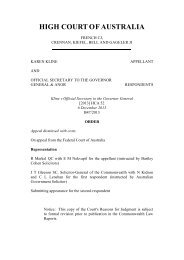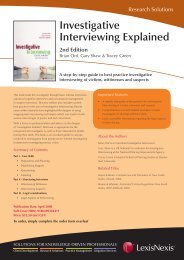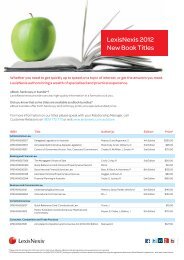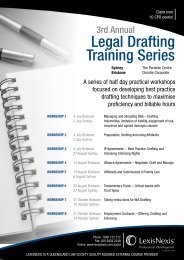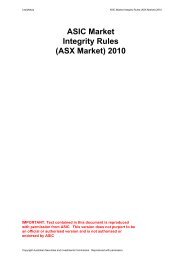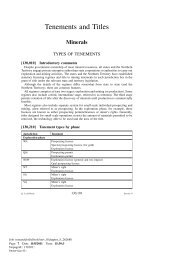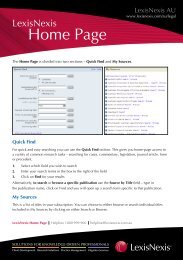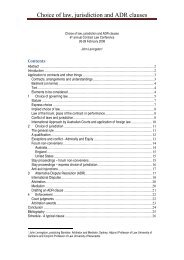Sample Introduction - LexisNexis
Sample Introduction - LexisNexis
Sample Introduction - LexisNexis
Create successful ePaper yourself
Turn your PDF publications into a flip-book with our unique Google optimized e-Paper software.
<strong>Introduction</strong> to the ASX ListingRules — AnnotationsThe Listing Rules . . . . . . . . . . . . . . . . . . . . . . . . . . . . . . . . . . . . . . . . . . . . . . . . . . . . . [0.1]ASX’s objectives . . . . . . . . . . . . . . . . . . . . . . . . . . . . . . . . . . . . . . . . . . . . . . . . . . . . . . [1.5]The principles on which the Listing Rules are based . . . . . . . . . . . . . . . . . . [1.10]Approved CS Facility — ASTC Settlement Rules & ACH ClearingRules . . . . . . . . . . . . . . . . . . . . . . . . . . . . . . . . . . . . . . . . . . . . . . . . . . . . . . . . . . . . . . . [1.20]Use of the ASX Listing Rules . . . . . . . . . . . . . . . . . . . . . . . . . . . . . . . . . . . . . . . . [0.25]Guidance Notes . . . . . . . . . . . . . . . . . . . . . . . . . . . . . . . . . . . . . . . . . . . . . . . . . . . . . . . [0.30]<strong>LexisNexis</strong> 0Service 0Job: commercial/annlr/allvols/serv_0/intro_251951Page: 1 Date: 15/7/2011 Time: 17:17:9bwpageid:: 0::bwservice::0::
ANNLR[The next page is 0]Service 0 1 <strong>LexisNexis</strong>Job: commercial/annlr/allvols/serv_0/intro_251951Page: 2 Date: 15/7/2011 Time: 17:17:9bwpageid:: 1::bwservice::0::
<strong>Introduction</strong> to the ASX ListingRules — Annotations[Editorial note: The ASX has included an <strong>Introduction</strong> to the Listing Rules. Theannotations that follow pertain to this][0.1] The Listing Rules[0.1.A] General principle and ASX policyASX Limited (“ASX”) is a public company that is authorised under the CorporationsAct (“the Act”) to operate a “financial market” in securities, derivatives and certain otherfinancial products. In that capacity it holds an “Australian market licence” issued by theCommonwealth Treasurer under s 796A of the Act: see para [0.1.C] for a link to theAustralian market licence (and amendments) granted to ASX.Although ASX is authorised to operate one or more financial markets in securities,derivatives and other financial products, the Listing Rules are concerned only with themarket which ASX operates for the trading of “securities”. Other markets operated byASX (eg in warrants, exchange traded options and ASX futures) are not covered by theListing Rules.An operator of a licensed market will have “operating rules” (as defined in s 761A ofthe Act) which regulate how the market is operated and how persons (“participants”)conduct themselves on that market. The “operating rules” of a licensed market includeany “listing rules” of the market (again as defined in s 761A). The listing rules of alicensed market regulate the admission of entities (issuers) to the market’s official list andthe conduct of those entities for the purpose of enabling the securities of those issuers tobe traded on the financial market.The ASX Listing Rules are therefore “operating rules” of the market operated by ASXand issuers admitted to ASX listing are “participants” in that market. Brokers and otherpersons who execute transactions directly on the market are also “participants” in themarket and ASX has other operating rules that regulate their conduct. ASIC also regulatesthe conduct of participants through the ASIC ASX Market Integrity Rules (see below forfurther information on the Market Integrity Rules).As the holder of an Australian market licence, ASX has an obligation to:• do all things necessary (to the extent reasonably practicable) to ensure that itoperates a “fair, orderly and transparent” market (s 792A(a));• deal with the matters prescribed by the Corporations Regulations in its operatingrules (s 793A and Corporations Regulation 7.2.07); and• have adequate arrangements for operating the market, including monitoring andenforcing compliance with its operating rules (s 792A(b)(ii)).Although the Listing Rules (and other “operating rules”) are prepared by ASX itself,the content of the Listing Rules is to a large extent influenced by the obligations which areimposed upon ASX itself under the Corporations Act. The Listing Rules should be viewedin this context.In deciding whether to grant an Australian market licence, the Treasurer is required tobe satisfied that the operating rules (including any “listing rules” as defined) are adequateto ensure, as far as is reasonably practicable, that the market will operate in a “fair, orderlyand transparent” manner (s 795B(1)(c)). Any changes to the Listing Rules must be<strong>LexisNexis</strong> 0Service 0Job: commercial/annlr/allvols/serv_0/intro_251951Page: 3 Date: 15/7/2011 Time: 17:17:9bwpageid:: 0::bwservice::0::
ANNLR[0.1.A]notified by ASX to ASIC within 21 days after the change is made and the Treasurer maydisallow all or part of a change to the Listing Rules if the change is considered to beinconsistent with ASX’s obligations, including the obligation to operate a fair, orderly andtransparent market (s 793E of the Act).What this means in practice is that, whilst ASX has a very broad discretion in how itadministers the admission and removal of entities and securities from listing andquotation, ASX is under an obligation to administer its Listing Rules as written and in amanner that best promotes a fair orderly and transparent market: see para [0.15.A] fornotes on ASX’s discretion in administering the Listing Rules.It is important to distinguish between:• the Listing Rules which regulate the conduct of “issuers” (ie entities that are“admitted” to the official list of ASX as issuers); and• the other rules which regulate brokers and other participants who executetransactions on the ASX market.Since 1 August 2010, brokers and other participants who execute transactions on theASX market are now dually regulated:• by ASX under the operating rules by which ASX admits participants to becometrading participants on the market; and• by ASIC under the Market Integrity Rules which govern the market conduct andclient agreements and disclosures required of market participants.Although ASX states in the <strong>Introduction</strong> that the Listing Rules are not merelycontractual obligations, the legal framework in which the Listing Rules operate needs tobe understood clearly.The Listing Rules do not (with one exception in relation to continuous disclosure)impose any direct obligations under the Corporations Act on entities admitted to ASXListing. The binding effect of the Listing Rules upon entities admitted to listing istherefore primarily contractual.See para [3.1.C.10]* for notes on the Corporations Act obligations of an issuer unders 674 of the Act, in relation to the continuous disclosure provisions of the Listing Rules.However, where either an entity admitted to listing or ASX itself has failed to meet anobligation under the Listing Rules, certain provisions of the Corporations Act allow ASIC,ASX and “any person aggrieved” to apply to court for an order giving directions to theperson who has failed to comply with the Listing Rules (s 793C). It should be noted thatthis is very different from a direct compliance obligation under the Act (a breach of whichwould be an offence), but instead relies for its binding force upon the court givingdirections to a person: see para [0.1.B] for notes on the enforcement of the Listing Rulesunder ss 793C and 1101B.Unlike the other “operating rules” of ASX (which are given statutory effect as acontract under seal between all market participants and ASX: see s 793B), the ASXListing Rules are specifically excluded from this deeming provision.Because of this, ASX needs to ensure that each entity admitted to the official list iscontractually bound to comply with the Listing Rules. ASX achieves this through theListing Application and Agreement which includes the following provision (executed asa contract under seal):We will comply with the listing rules that are in force from time to time, even if quotation of oursecurities is deferred, suspended or subject to a trading halt.ASX does not have any power to impose fines or direct sanctions on an entity admittedto ASX listing, but can suspend or remove an entity or its securities from listing and/orquotation if the entity breaches the Listing Rules. This is acknowledged by an entityService 0 1 <strong>LexisNexis</strong>Job: commercial/annlr/allvols/serv_0/intro_251951Page: 4 Date: 15/7/2011 Time: 17:17:9bwpageid:: 1::bwservice::0::
[0.1.A]INTRODUCTION TO THE ASX LISTING RULES — ANNOTATIONSseeking admission in the Listing Application and Agreement: see paras [1.7.A], [1.9.A]and [1.14.A] for notes on the Listing Application and Agreement in the form of Apps 1A,1B or 1C as appropriate.Because ASX is, in practical terms, under an obligation as a market operator to applythe Listing Rules as written and in accordance with the objectives set out in theCorporations Act, ASX’s discretion to waive compliance with the Listing Rules existssolely within the framework for waivers set out in the Listing Rules itself: see paras[18.1.A]*, [18.3.A]* and [18.5.A]* for notes on ASX’s discretion to grant waivers and/ornot enforce the Listing Rules in particular circumstances under LRs 18.1, 18.3 and 18.5.ASX remains subject to oversight by ASIC under the Corporations Act, which reportsannually on how well ASX is complying with its obligations as a market licensee(s 794C). These reports include consideration of the ongoing effectiveness of the ListingRules and ASX’s administration of those Rules.See para [0.1.C] for a link to the latest ASIC Market Assessment Report on ASX andits related entities.Further, on 30 June 2004, ASIC and ASX signed a memorandum of understandingwhich outlined the complementary roles of ASIC and ASX and which aimed at improvingthe efficiency of ASIC and ASX’s supervision of the market. In particular, paragraph 16of the Memorandum of Understanding, as complemented by s 792B(2)(c) of the Act,requires ASX to give written notice to ASIC (commonly referred to as a referral) as soonas practicable if it suspects that a person has committed, is committing or is about tocommit a significant contravention of the operating rules (ie the listing rules) or the Act:see para [0.1.C] for a link to the Memorandum of Understanding between ASX and ASIC.Finally, there is one other important aspect of the conduct of a listed entity under theListing Rules which needs to be observed closely and that is in the provision ofinformation to ASX. This is because it is an offence under s 1309 of the Corporations Actfor an officer or employee of a corporation to provide false or misleading information toASX in its capacity as a market operator: see para [0.1.B] for notes on s 1309 of the Act.[0.1.B]Legislation and ASIC policy• Licensing of financial markets including definitions of “financial market”,“operating rules”, “listing rules” and “participant” under Part 7.2 of the CorporationsActAs mentioned above, the ASX operates a licensed financial market under Pt 7.2 of theCorporations Act. Section 791A of the Act generally prohibits a person from operating orholding out that it operates a financial market in Australia, unless that person holds anAustralian market licence authorising it to do so. An entity wishing to operate a financialmarket in Australia (other than an exempt financial market under s 791C) would need toapply to ASIC for a financial market licence.Section 767A of the Act defines a financial market as a facility through which offers toacquire or dispose of financial products are regularly made or accepted. RegulatoryGuide 172: Australian Market Licences: Australian Operators provides guidance onASIC’s approach to licensing operators of financial markets, including ASIC’s approachto exemptions and how to apply for a market licence.Specifically, RG 172 provides commentary on the definitions of a “facility”, “offers”,“invitations”, “made” or “accepted”, and importantly, what “regularly” means in thecontext of s 767A.In granting an Australian market licence, ASIC usually imposes conditions on thelicensee to ensure that the licensee operates a fair, orderly and transparent market. These<strong>LexisNexis</strong> 2Service 0Job: commercial/annlr/allvols/serv_0/intro_251951Page: 5 Date: 15/7/2011 Time: 17:17:9bwpageid:: 2::bwservice::0::
ANNLR[0.1.B]conditions may range from specific notification requirements to detailed reportingrequirements, such as annual reports. Section 792A of the Act sets out the generalobligations of the market licensee.Further, a licensee is required to have operating rules and to monitor and enforcecompliance with the market’s operating rules.Under s 761A of the Act, the operating rules of a market licensee include:any rules (however described), including the market’s listing rules (if any), thatare made by the operator of the market, or contained in the operator’sconstitution”, and that deal with:(i) the activities or conduct of the market; or(ii) the activities or conduct of persons in relation to the market.Under s 761A of the Act, the “listing rules” are defined as being those operating rulesthat deal with:(a) admitting entities to, or removing entities from, the market’s official list, whetherfor the purpose of enabling financial products of those entities to be traded on themarket or for other purposes; or(b) the activities or conduct of entities that are included on that list.It can be seen from the above definitions that a distinction needs to be drawn betweenthe ASX Listing Rules (which regulate only entities admitted to the official list) and theother “operating rules” of ASX which regulate “participants in the ASX market.This distinction between an ‘issuer’ and ‘participant’ is an important one.Section 761A defines a “participant” to be a person who is allowed to directlyparticipate in the financial market. Participants other than listed entities are admitted byASX as market participants under the ASX Operating Rules. These persons or entities aregenerally referred to as broker participants, “stockbrokers” or simply “brokers”.Issuers on the other hand are the entities which are admitted to the official list of theASX and are usually referred to as ‘listed entities’. The majority of issuers arecorporations, companies or registered managed investment schemes, however ASX doesnot have a direct requirement that an issuer be a corporation, provided its structure andoperations are suitable for listing: see paras [1.1.A.10], [1.1.A.10A] and [1.1.A.50] fornotes on LR 1.1, Conditions 1, 1A and 5 which relate to the structure and operations oflisted entities.On 1 August 2010, the supervision and enforcement of rules in relation to the marketconduct and client relationships of market participants was transferred to ASIC. Whilstmarket participants are still admitted to participate in the ASX markets by ASX (under itsoperating rules), market participants are now also subject to supervision and enforcementby ASIC under the ASIC ASX Market Integrity Rules. The Market Integrity Rules do notaffect the supervision or enforcement role of ASX over listed entities under the ASXListing Rules, which remains unchanged.• Other licensed financial marketsASX is one of five licensed financial market operators in Australia. The others being:• the National Stock Exchange of Australia (NSXA);• the SIM Venture Securities Exchange Ltd (SIM VSE) (formerly Bendigo StockExchange Ltd);• the Asia Pacific Exchange Limited; and• Chi-X Australia Pty Ltd (authorised in May 2011 as a trading market but not asa listing market).In terms of the numbers of listed entities, ASX operates the largest market out of eachof the licensed financial markets, with more than 2200 admitted to its official list.Service 0 3 <strong>LexisNexis</strong>Job: commercial/annlr/allvols/serv_0/intro_251951Page: 6 Date: 15/7/2011 Time: 17:17:9bwpageid:: 3::bwservice::0::
[0.1.B]INTRODUCTION TO THE ASX LISTING RULES — ANNOTATIONSMost recently, Chi-X Australia Pty Ltd was granted a market license to operate asecondary equity-product trading market in May 2011. Indications are that Chi-X willcommence trading in the fourth quarter of 2011. Chi-X will compete directly with theASX in regards to participants.Chi-X’s licence allows it to operate a market through which participants may enter intotrades of certain financial products. As a condition of its licence, Chi-X must haveclearing and settlement arrangements for transactions effected through the market withASX Clear Pty Ltd and ASX Settlement Pty Ltd, or an entity prescribed by ASIC.It is important to note that Chi-X will not be operating a financial market in respect oflisting or issuers; rather it will focus primarily on the participant side of the financialmarket. In other words, an entity cannot list or be admitted to Chi-X, however participantsor brokers can transact through Chi-X.Chi-X will initially begin its operations with a small number of the most liquidsecurities on the ASX market, with intentions to expand to the S&P/ASX 200 index.Chi-X is a wholly owned subsidiary of Chi-X Global, which has subsidiaries andoperates markets in Canada, Japan and Singapore.See following paragraphs below for further commentary on the transfer of powers toASIC and for further commentary on the Market Integrity Rules.• ASIC assumption of the supervision of market integrity rules• On 1 August 2010, Pt 7.2A was inserted into the Act. Part 7.2A sets out ASIC’ssupervision powers of financial markets.In effect, Pt 7.2A resulted in the transfer from ASX to ASIC of the supervisionof participants in the ASX markets, thus giving ASIC the power to both superviseand enforce breaches in relation to the ASX financial market.Note however, this transfer was only in relation to supervising the trading andconduct of participants, rather than the listed entities themselves. Accordingly,ASX still retains the power to monitor the compliance of entities listed on itsfinancial market, whilst ASIC has the power to supervise and enforce complianceagainst the participants.• Further, under Pt 7.2A, ASIC established the Market Integrity Rules. The MarketIntegrity Rules govern the activities or conduct in relation to:• licensed markets;• persons in relation to licensed markets; and• persons in relation to financial products traded on licensed markets.The Market Integrity Rules are a legislative instrument, and hence are subject toparliamentary scrutiny.In releasing the Market Integrity Rules, ASIC also issued two supportingregulatory guides.Regulatory Guide 214 provides guidance on the ASIC market integrity rules forASX and ASX 24 markets, whilst RG 215 provides guidance for APX, IMB,NSXA and SIM VSE markets.Regulatory Guide 214 also provides guidance on how the ASIC Market IntegrityRules should be complied with and ASIC’s approach to supervising compliance.• Court enforcement of the Listing RulesSection 793C of the Act empowers the court to enforce compliance with the operatingrules of a licensed market. Section 793(1) allows ASIC, a market licensee or the operatorof a clearing and settlement facility or a person aggrieved by a failure to comply with orenforce the operating rules of a licensed financial market to make an application to thecourt for directions.<strong>LexisNexis</strong> 4Service 0Job: commercial/annlr/allvols/serv_0/intro_251951Page: 7 Date: 15/7/2011 Time: 17:17:9bwpageid:: 4::bwservice::0::
ANNLR[0.5.A]Section 793C gives each of the above parties the ability to seek court orders to enforcethe ASX Listing Rules.Sections 793C(3) and 793C(4) reinforce the contractual obligation of a listed entity tocomply with the Listing Rules by stating that the listed entity (or in the case of a listedtrust, the responsible entity of the trust) is taken to be under an obligation to comply withthat market’s operating rules.This means that a listed entity have both a contractual obligation to comply with theListing Rules (ie by execution of an App 1A at the time of listing), as well being deemedfor the purpose of s 793C to have an obligation to comply with the Listing Rules.However, failure to comply with the Listing Rules is not an offence under s 793C, unlessa court makes an order directing compliance and that order is ignored.Section 793C is supported by s 1101B, which sets out the power of the courts to makea broad range of orders. The range of orders may be dependent on the person bringing theaction: see para [1.7.A] for notes on the contractual obligations under the ListingAgreement in App 1A.• Offence under the Corporations ActAs mentioned in para [0.1.A] above, there are two aspects in which a breach of theListing Rules can result in an offence being committed under the Corporations Act.Section 1309 of the Act creates a specific offence for the provision of false informationto the ASX or an officer of ASX or a market operator.The section is broad and is not limited to upper management or officers and applies toboth:• actively giving misleading information; or• omitting particular information which renders it misleading in a material respect.Section 1309 has two key components, in that s 1309(1) involves the giving of falseinformation, whilst s 1309(2) involves the failure to ensure the veracity of information.In particular, s 1309(2) requires the person giving the information to have takenreasonable steps to ensure that the information was not false or misleading in a materialparticular, or did not have omitted from it a matter or thing the omission of which wouldrender the information provided to be misleading.Further, s 674 of the Act specifically sets out continuous disclosure offences, alongsidess 1317DAA–1317DAJ which allows ASIC to issue infringement notices, s 1324B inregards to civil penalties and s 1311 in regards to criminal liability for breach of anentity’s continuous disclosure obligations: see para [3.1.C.10]* for a discussion on s 674and the ASX continuous disclosure regime.[0.1.C] Further References• Australian Market Licence (ASX Limited) 2002 (granted 8 March 2002 andvaried on 11 March 2006 and 4 December 2006);• ASIC Regulatory Guide 172 (Australian market licences: Australian operators);• ASIC Market Assessment Report: ASX Group (November 2010);• Memorandum of Understanding between Australian Securities and InvestmentsCommission and Australian Stock Exchange Limited dated 30 June 2004;• ASIC Regulatory Guide 214;• ASIC Regulatory Guide 215.[0.5] ASX’s objectives[0.5.A] General principle and ASX policyThe stated objectives of ASX in the <strong>Introduction</strong> reflect the obligations of ASX as theholder of an Australian market licence, described in para [0.1.A]. They are also indicativeService 0 5 <strong>LexisNexis</strong>Job: commercial/annlr/allvols/serv_0/intro_251951Page: 8 Date: 15/7/2011 Time: 17:17:9bwpageid:: 5::bwservice::0::
[0.5.A]INTRODUCTION TO THE ASX LISTING RULES — ANNOTATIONSof the policy approach which ASX takes when considering waivers and/or amendments tothe Listing Rules, which includes a comparative consideration of relevant practices inother major jurisdictions.[0.10] The principles on which the Listing Rules are based[0.10.A] General principle and ASX policyThe principles set out in the <strong>Introduction</strong> are important considerations in theinterpretation and administration of the Listing Rules. It is well established that theListing Rules are not intended to be interpreted in the same way as legislation, but areinstead intended to be applied in a purposive way with wide latitude for ASX to apply theListing Rules in a way that best promotes the principles on which the Rules are based.Consistent with the principles set out in the <strong>Introduction</strong>, the Listing Rules can begrouped broadly into rules which satisfy four main objectives in the conduct of thefinancial market, by ensuring:• minimum standards of quality, size, operations and shareholding in listedentities;• integrity and transparency in the trading of an entity’s securities;• fairness as between holders of the entity’s securities;• certainty as to the trading and settlement of an entity’s securities and the rightsof holders of an entity’s securities.The principles set out in the <strong>Introduction</strong> apply broadly across all the listing Rules,although some principles are more relevant to particular Listing Rules than others. Asregards the four broad objectives described above, some of the Listing Rules satisfy morethan one of these objectives. For example, Ch 10 (Transactions with persons in a positionof influence) is relevant to both the objective of fairness (by requiring security holderapproval for transactions) as well as the objective of integrity and transparency (byrequiring disclosure and ensuring that directors are not seen to be benefitting fromtransactions which they have themselves approved): see para [0.15.A] for notes on thepurposive interpretation of the Listing Rules.[0.10.B] Further References• The Role of the Australian Stock Exchange and its Listing Rules, ASXDiscussion Paper 4 (October 1990).[0.15] Application of the Listing Rules[0.15.A] General principle and ASX policyThis section of the <strong>Introduction</strong> repeats ASX’s absolute discretion regarding theadmission of an entity to the official list (and its removal) and the quotation of an entity’ssecurities (and the suspension of those securities from quotation). This absolute discretionis reinforced by the provisions of the Listing Application and Agreement where an entityseeking admission acknowledges the absolute discretion of ASX in relation to suchmatters. It is also repeated in LR 1.19.Of course, in exercising its absolute discretion, ASX is still bound by its obligationsunder the Corporations Act to administer the Listing Rules in a way that is consistent withits obligations as a market licensee. Should ASX exercise its discretion in a manner whichis inconsistent with those obligations then ASIC will almost certainly report adversely onthat and adverse action could then be taken by the regulator as a result.A listed entity or an entity seeking admission under the Listing Rules can be a “personaggrieved” by a failure of ASX to meet its obligations under the Listing Rules (eg where<strong>LexisNexis</strong> 6Service 0Job: commercial/annlr/allvols/serv_0/intro_251951Page: 9 Date: 15/7/2011 Time: 17:17:9bwpageid:: 6::bwservice::0::
ANNLR[0.20.B]the entity believes that it has been refused admission to listing in circumstances whereother entities have received approval). This could potentially allow an entity to apply tothe court for orders directing ASX to take certain actions under s 793C of theCorporations Act, and such applications have been made. However, the absolutediscretion of ASX in such decisions would be a significant impediment to pursuing sucha claim as it is likely to be difficult to identify an”obligation” by ASX under the ListingRules which it has failed to meet.As mentioned in para [*] above, ASX’s discretion to waive or not enforce compliancewith the Listing Rules exists solely within the framework for waivers set out in the ListingRules itself as set out in Ch 18 of the Listing Rules. So any discretion which ASX has inthis regard is limited by the obligation to administer its Listing Rules as written and in amanner that best promotes a fair orderly and transparent market: see para [0.1.A] abovefor notes on how the Listing Rules fit within the regulatory framework which governsASX as the holder of an Australian market licence under the Corporations Act.This section of the <strong>Introduction</strong> also sets out the basis for a purposive interpretation ofthe Listing Rules in accordance with the principles set out in the <strong>Introduction</strong> (seepara [0.10.A] above). Such a basis for interpretation is given effect to by theacknowledgement which each entity seeking admission is required to give in the ListingApplication and Agreement as follows:‘The listing rules are to be interpreted:• in accordance with their spirit, intention and purpose;• by looking beyond form to substance; and• in a way that best promotes the principles on which the listing rules arebased.’[0.20] Approved CS Facility — ASTC Settlement Rules & ACHClearing Rules[0.20.A] General principle and ASX policyIn order for an entity’s securities to be quoted and traded on ASX, transactions insecurities must be able to be completed by payment or delivery of securities. Completionof transactions on the ASX market is effected through the electronic “clearing andsettlement facility” which has been approved for this purpose. This means that transfersof securities are effected without the delivery of share certificates or the completion ofpaper transfer forms. This is referred to as a trading in “uncertificated” securities. In anuncertificated trading and settlement system it is necessary for the securities which areissued to be compatible with the requirements for electronic trading (eg for there to be norestrictions on transfers under the terms of issue).Clearing and settlement facilities must be licensed under the Corporations Act andapproved by ASX. The primary clearing and settlement facility is provided by the ASXsubsidiaries ASX Clear Pty Ltd and ASX Settlement Pty Ltd, but it is possible that, infuture, alternative clearing and settlement facilities may be established for this purpose.The Listing Rules use the expression “approved CS facility” which is a defined termunder LR 19.12. The electronic clearing and settlement facility provided by the ASXsubsidiaries ASX Clear Pty Ltd and ASX Settlement Pty Ltd is referred to as the“CHESS” system, which stands for the “Clearing House Electronic Settlement System”(see definition of “CHESS” in LR 19.12).[0.20.B] Legislation and ASIC policyUnder s 768A of the Corporations Act, a clearing and settlement facility is defined as:Service 0 7 <strong>LexisNexis</strong>Job: commercial/annlr/allvols/serv_0/intro_251951Page: 10 Date: 15/7/2011 Time: 17:17:9bwpageid:: 7::bwservice::0::
[0.20.B]INTRODUCTION TO THE ASX LISTING RULES — ANNOTATIONS“a facility that provides a regular mechanism for the parties to transactionsrelating to financial products to meet obligations to each other that:(a) arise from entering into the transactions; and(b) are of a kind prescribed by regulations made for the purposes of [s 768A(b)]”.Corporations Reg 7.1.09 specifies that obligations arising from contracts to transfercertain financial products are prescribed for the purpose of s 768A. By prescribing thetransfer of a broad range of financial products (including shares and managedinvestments) this Regulation in effect underpins the obligation for any clearing andsettlement facility for listed shares and managed investment trust units to be a licensedclearing and settlement facility under the Act.Under s 820A of the Act a person is only permitted to operate a clearing and settlementfacility in Australia if either the facility is exempt, or if the person holds an “AustralianCS facility licence”, granted under Pt 7.3 of the Act. The ASX entities which operateCHESS hold Australian CS facility licences: see para [0.20.C] for further reference detailsfor the licences.The holder of an Australian CS Facility licence has obligations in relation to theconduct of the clearing and settlement facility. These obligations are set out in Div 2 ofPt 7.3 of the Act (ss 821A and following), and include the obligation to have “operatingrules” which deal with certain matters. The operating rules for the clearing and settlementfacility operated by ASX Clear Pty Ltd and ASX Settlement Pty Ltd are the “ASX ClearOperating Rules” and the “ASX Settlement Operating Rules”.[0.20.C] Further ReferencesAustralian CS Facility Licence (Australian Clearing House Pty Limited) 2002, asvaried by:(a) Australian CS Facility Licence (Options Clearing House Pty Limited) VariationNotice 2002 (No 1); and(b) Australian CS Facility Licence (Options Clearing House Pty Limited) VariationNotice 2004 (No 1); and(c) Australian CS Facility Licence (Australian Clearing House Pty Limited)(Additional Conditions) Notice 2005 (No 1); and(d) Australian CS Facility Licence (Australian Clearing House Pty Limited)Variation Notice 2010 (No 1); and(e) Australian CS Facility Licence (Australian Clearing House Pty Limited)Variation Notice 2010 (No 2).Australian CS Facility Licence (ASX Settlement and Transfer Corporation Pty Limited)2002, as varied by:(a) Australian CS Facility Licence (ASX Settlement and Transfer Corporation PtyLimited) Variation Notice 2004 (No 1); and(b) Australian CS Facility Licence (ASX Settlement and Transfer Corporation PtyLimited) Variation Notice 2010 (No 1); and(c) Australian CS Facility Licence (ASX Settlement and Transfer Corporation PtyLimited) Variation Notice 2010 (No 2).[0.25] Use of the ASX Listing Rules[0.25.A] General principle and ASX policyThe important points to note under this heading are:• the extensive use of defined terms throughout the Listing Rules (Chapter 19 setsout the meaning of defined terms);and<strong>LexisNexis</strong> 8Service 0Job: commercial/annlr/allvols/serv_0/intro_251951Page: 11 Date: 15/7/2011 Time: 17:17:9bwpageid:: 8::bwservice::0::
ANNLR[0.30.A]• that the use of notes and examples by ASX to clarify the Listing Rules is not tobe taken to limit ASX’s discretion or to change the interpretation of the relevantListing Rule.[0.30] Guidance Notes[0.30.A] General principle and ASX policyAs with notes appearing within the Listing Rules, this paragraph makes it clear that theASX Guidance Notes are not intended to limit ASX’s discretions as to how it applies theListing Rules, nor as a substitute for legal advice on the topic. Nonetheless, the GuidanceNotes do give quite comprehensive guidance to ASX’s policy and practice in some casesand are generally consistent with the way in which ASX has granted waivers. Thispublication cross refers to the ASX Guidance Notes on many occasions to support orillustrate an annotation.Service 0 9 <strong>LexisNexis</strong>Job: commercial/annlr/allvols/serv_0/intro_251951Page: 12 Date: 15/7/2011 Time: 17:17:9bwpageid:: 9::bwservice::0::



